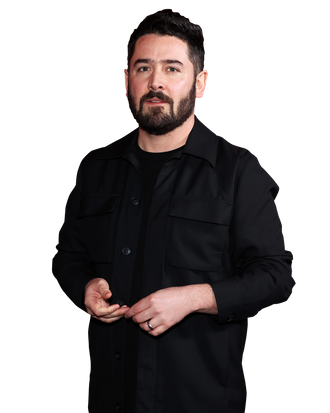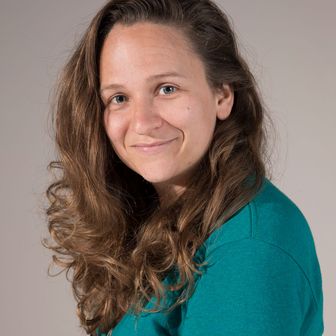
The story of the movie Vivarium dates all the way back to 2011, when director Lorcan Finnegan and screenwriter Garret Shanley made a short film called Foxes, about a young couple that gets trapped in an empty housing development. Just rows of anodyne residences they can’t manage to escape, a prefab suburban wasteland. Finnegan says the idea came from the “ghost estates” that emerged when the Irish economy tanked, along with the rest of the world’s, during the financial collapse of the late 2000s. The construction boom lead to a housing surplus, which led to buyers’ taking out bad mortgages and then going underwater when the market was obliterated, leaving them “financially and emotionally sort of trapped in their homes,” says Finnegan.
Now the feature film version of Foxes, called Vivarium, is getting commercially released into a world where huge chunks of the global population are literally trapped in their houses. (That a film based on the specter of one recession is entering the world on what might be the precipice of another is not lost on us, either.) It stars Imogen Poots as Gemma and Jesse Eisenberg as Tom, a young couple looking to purchase their first home. They’re just checking out a lot in ultraboring Yonder housing development when their creepy real estate agent disappears from the tour. Gemma and Tom get in their car to leave but every turn just leads them back to Number 9.
They soon realize that all their basic needs are taken care of, with food and hygiene products mysteriously delivered to the front gate. But with an indefinite sentence in subdivision purgatory, Jesse and Tom start breaking apart, lashing out, and searching for new ways to cope. As Tom’s health declines, he starts digging a huge hole in the front yard. (Note to self: Try stress digging in the front yard tomorrow?) Considering its extremely on-the-nose themes, Vulture spoke with Finnegan from a safe distance over the phone about making a movie about a hell that sometimes seems like it’s coming true.
Tell me about how you ramped up the claustrophobia and monotony of going stir-crazy in your house. Our homes are these safe places we make for ourselves, and now suddenly they are our prisons.
I remember seeing the film The Witches — the Roald Dahl film that was directed by Nicolas Roeg with Anjelica Huston — and there was a scene with a painting of this little girl who was trapped inside by a witch. Every day, she’d kind of be in a different position around the painting, and she kept getting older and older until one day she just disappeared. I find that quite horrific and haunting, so I wanted to make this environment also feel like a painting, with some sort of tangible yet artificial and anxiety-inducing environments that they’re trapped in. Like, part of the color scheme is an experiment in anxiety with the kind of minty greens. Taken out of nature, it completely takes on a very toxic quality. It’s like it’s poisonous and also quite institutional, like a hospital or a school or something like that.
As a filmmaker, you can’t know what sort of world your movie will arrive in or what meanings it will take on compared to what you intended. Vivarium debuted at Cannes last year, but now it’s dropping into this surreal environment where capitalism theoretically had everything working and humming along, and it basically took about a week to disprove that, and now we’re all under a form of house arrest. How’s that for you?
It’s so weird. Sometimes I think films are a bit like — they pop up as if there’s a network between all of humanity, like there’s a subconscious thread that’s connecting everything and films are just the manifestation of these sort of anxieties that everybody has. I don’t know if in some way they’re prescient and can foretell what’s about to happen, but there’s lots of weird parallels in Vivarium. You know, obviously a couple stuck at home with a child that is driving them mad, watching stuff on a screen they can’t really comprehend. Jesse’s character develops a mysterious cough, an illness. There’s body bags. There’s even illustrations in the book that Gemma reads that show this weird kind of virus-y looking sphere above an illustration of a man, woman, and child, where the man and woman have, like, an extinction symbol on their foreheads and the child doesn’t. They even get all their stuff just delivered to them in packages like everybody’s doing now. The parallels are just kind of creepy.
It’s a very strange time, a little bit like you’ve taken acid or something and you’re not sure when it’s gonna end because the trip is going on for way too long. It’s all fascinating and frightening and developing really quickly, but at the same time, nobody knows when it’s going to end or what the world is even going to look like afterwards. Even the idea when you see people now, I watched a film last night, and there were people, you know, touching and buying things and it all just seemed so strange. Like, “Oh my God, you can’t touch your nose and then you grab something in the store!”
Is our collective isolation playing out on our psyches like you’d expected?
Actually, what is interesting is that from where we were when we were working on the story, we’d be worried, “Would people accept these kinds of things?” Part of that was then creating this very surreal atmosphere, because things that are slightly dreamy — in a way — you kind of can accept more strangeness as an audience. But it’s amazing to see how people now have accepted things within a week. Suddenly your brain shifts so quickly and you see somebody walking towards you on the footpath and you’re like, “Oh, cross the road!” It’s almost becoming instinctual to wash your hands so often and be suspicious of any kind of ringing of the doorbell within only a few days. So for these guys in the film, I guess they would accept their strange reality quite quickly. It’s actually seems more plausible.
Is that more rapid acceptance a positive or a negative, do you think? In a way, it’s an immediate conditioning to see others as a threat.
I don’t know. I think we’re all being compliant — well, not everybody is, obviously — but we’re trying to be compliant so that things do return back to normal before we forget what normal was. But if this is what it’s like after a week, in three months’ time, who knows what we’ll be like? We’re social creatures. There’s only so many video parties or Zoom conferences or whatever you can do with your friends before you kind of lose your mind, you know? We kind of need a little bit of contact.
Have you been surprised at all by your own movie when considering it through the context of the world it’s premiering in?
The world where it premiered in last May at Cannes was a different world than it is now. Cannes this year has been canceled, but I think Vivarium was the product of a culture that was at a tipping point in terms of its kind of capitalist goals and extreme consumerism and greed. It did feel like something was going to break one way or the other. It kind of had to in some ways. It’s become untenable, and I think there’s a bunch of films like that at the moment that are reactions to the boiling points. I watched The Platform a couple of days ago, and that’s sort of in the same world. You know, it’s like the greed from the top and the disparity between the rich and the poor. You can see what those films were saying about culture and society at a time when it was at its most turbulent.


